-
TPS62231x-Q1 3-MHz Ultra-Small Step-Down Converter in 1 × 1.5 SON Package SLVSB63A December 2011 – March 2016 TPS62231-Q1 , TPS622314-Q1
PRODUCTION DATA.
-
TPS62231x-Q1 3-MHz Ultra-Small Step-Down Converter in 1 × 1.5 SON Package
- 1 Features
- 2 Applications
- 3 Description
- 4 Revision History
- 5 pPin Configuration and Functions
- 6 Specifications
- 7 Detailed Description
- 8 Application and Implementation
- 9 Power Supply Recommendations
- 10Layout
- 11Device and Documentation Support
- 12Mechanical, Packaging, and Orderable Information
- IMPORTANT NOTICE
Package Options
Mechanical Data (Package|Pins)
- DRY|6
Thermal pad, mechanical data (Package|Pins)
- DRY|6
Orderable Information
TPS62231x-Q1 3-MHz Ultra-Small Step-Down Converter in 1 × 1.5 SON Package
1 Features
- Qualified for Automotive Applications
- Up to 3.8-MHz Switch Frequency
- Up to 94% Efficiency
- Output Peak Current up to 500 mA
- Excellent AC and Transient Load Regulation
- High PSRR (up to 90 dB)
- Small External Output-Filter Components 1 μH and 4.7 μF
- VIN range from 2.05 V to 6 V
- Optimized Power Save Mode For Low Output-Ripple Voltage
- Forced PWM Mode Operation
- Typical 22-μA Quiescent Current
- 100% Duty Cycle for Lowest Dropout
- Small 1 × 1.5 × 0.6-mm3 SON Package
- 12-mm2 Minimum Solution Size
- Supports 0.6-mm Maximum Solution Height
- Soft Start With 100-μs (Typical) Start-Up Time
2 Applications
3 Description
The TPS6223x-Q1 device family is a high-frequency, synchronous step-down DC-DC converter ideal for space-optimized automotive and industrial applications. The device supports up to 500-mA output current and allows the use of tiny and low-cost chip inductors and capacitors.
With a wide input-voltage range of 2.05 V to 6 V, the device can be powered by a preregulated voltage rail or Li-Ion batteries with extended voltage range. Two different fixed-output voltage versions are available at 1.5 V and 1.8 V.
The TPS6223x-Q1 series features switch frequency up to 3.8 MHz. At medium to heavy loads, the converter operates in PWM mode and automatically enters Power Save Mode operation at light load currents to maintain high efficiency over the entire load current range.
Because of its excellent PSRR and AC load regulation performance, the device is also suitable to replace linear regulators to obtain better power conversion efficiency.
The Power Save Mode in TPS6223x-Q1 reduces the quiescent current consumption down to 22 μA during light load operation. It is optimized to achieve very low output voltage ripple even with small external component and features excellent AC load regulation.
For noise-sensitive applications, the device can be forced to PWM Mode operation over the entire load range by pulling the MODE pin high. In the shutdown mode, the current consumption is reduced to less than 1 μA. The TPS6223x-Q1 is available in a 1-mm × 1.5-mm2 6-pin SON package.
Device Information(1)
| PART NUMBER | OUTPUT VOLTAGE |
FREQUENCY |
|---|---|---|
| TPS62231-Q1 | 1.8 V | 3 MHz |
| TPS622314-Q1 | 1.5 V | 3 MHz |
- For all available packages, see the orderable addendum at the end of the data sheet.
Typical Application Schematic
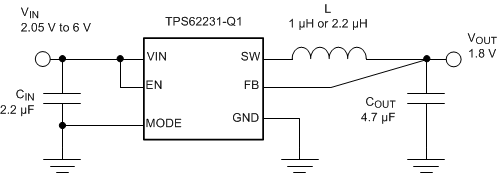
Small PCB Layout Size
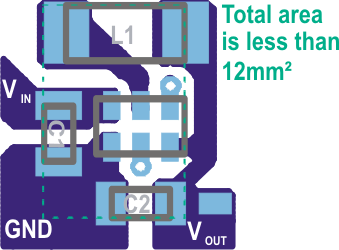
4 Revision History
Changes from * Revision (December 2011) to A Revision
- Added Pin Configuration and Functions section, ESD Ratings table, Thermal Information table, Feature Description section, Device Functional Modes, Application and Implementation section, Power Supply Recommendations section, Layout section, Device and Documentation Support section, and Mechanical, Packaging, and Orderable Information sectionGo
- Changed the Applications list Go
- Deleted the Ordering Information table Go
- Deleted references to devices and voltage options that are not available as automotive gradeGo
- Added minimum and maximum recommended values for output inductance and output capacitance in the Recommended Operating Conditions table for clarityGo
- Deleted the Dissipation Ratings table and added a more detailed Thermal Information tableGo
- Deleted the Parameter Measurement Information sectionGo
5 pPin Configuration and Functions
Pin Functions
| PIN | TYPE | DESCRIPTION | |
|---|---|---|---|
| NO. | NAME | ||
| 1 | MODE | IN | When the MODE pin is high, the device is forced to operate in PWM mode. When the MODE pin is low, the power save mode is enabled with automatic transition from PFM (pulse frequency mode) to PWM (pulse width modulation) mode. This pin must be terminated. |
| 2 | SW | OUT | This pin is the switch pin and is connected to the internal MOSFET switches. Connect the inductor to this pin. |
| 3 | VIN | PWR | VIN power supply pin. |
| 4 | GND | PWR | GND supply pin. |
| 5 | EN | IN | This is the enable pin of the device. Pulling this pin to low forces the device into shutdown mode. Pulling this pin to high enables the device. This pin must be terminated. |
| 6 | FB | IN | Feedback pin for the internal regulation loop. Connect this pin directly to the output capacitor. |
6 Specifications
6.1 Absolute Maximum Ratings
over operating free-air temperature range (unless otherwise noted)(1)| MIN | MAX | UNIT | |||
|---|---|---|---|---|---|
| VI | Voltage at VIN and SW pin(2) | –0.3 | 7 | V | |
| Voltage at EN, MODE pin(2) | –0.3 | (VIN + 0.3) ≤7 | V | ||
| Voltage at FB pin(2) | –0.3 | 3.6 | V | ||
| Peak output current | internally limited | A | |||
| Power dissipation | Internally limited | ||||
| TJ | Maximum operating junction temperature | –40 | 125 | °C | |
| Tstg | Storage temperature | –65 | 150 | °C | |
6.2 ESD Ratings
| VALUE | UNIT | |||
|---|---|---|---|---|
| V(ESD) | Electrostatic discharge | Human-body model (HBM), per AEC Q100-002(1) | ±2000 | V |
| Charged-device model (CDM), per AEC Q100-011 | ±1000 | |||
| Machine Model (MM) | 200 | |||
6.3 Recommended Operating Conditions
operating ambient temperature TA = –40 to 105°C (unless otherwise noted)(1)| MIN | NOM | MAX | UNIT | |||
|---|---|---|---|---|---|---|
| Supply voltage, VIN(4) | 2.05 | 6 | V | |||
| Effective output inductance | 0.7 | 1 or 2.2 | 4.3 | μH | ||
| Effective output capacitance | 2 | 4.7 | 15 | μF | ||
| Recommended minimum supply voltage | VOUT ≤ (VIN – 1 V)(2) | 500-mA maximum IOUT(3) | 3 | 3.6 | V | |
| 350-mA maximum IOUT(3) | 2.5 | 2.7 | ||||
| VOUT ≤ 1.8 V | 60-mA maximum output current(3) | 2.05 | ||||
| Operating junction temperature, TJ | –40 | 125 | °C | |||
| Ambient temperature, TA | –40 | 105 | °C | |||
6.4 Thermal Information
| THERMAL METRIC(1) | TPS62231x-Q1 | UNIT | |
|---|---|---|---|
| DRY (SON) | |||
| 6 PINS | |||
| RθJA | Junction-to-ambient thermal resistance | 294.5 | °C/W |
| RθJC(top) | Junction-to-case (top) thermal resistance | 166.5 | °C/W |
| RθJB | Junction-to-board thermal resistance | 166.1 | °C/W |
| ψJT | Junction-to-top characterization parameter | 27.3 | °C/W |
| ψJB | Junction-to-board characterization parameter | 159.9 | °C/W |
6.5 Electrical Characteristics
VIN = 3.6 V, VOUT = 1.8 V, EN = VIN, MODE = GND, TA = –40°C to 105°C(4), CIN = 2.2 μF, L = 2.2 μH, COUT = 4.7 μF, typical values are at TA = 25°C (unless otherwise noted).| PARAMETER | TEST CONDITIONS | MIN | TYP | MAX | UNIT | ||
|---|---|---|---|---|---|---|---|
| SUPPLY | |||||||
| VIN | Input voltage range(5) | 2.05 | 6 | V | |||
| IQ | Operating quiescent current | IOUT = 0 mA. PFM mode enabled (MODE = 0) device not switching |
22 | 40 | μA | ||
| IOUT = 0 mA. PFM mode enabled (MODE = 0) device switching, VIN = 3.6 V, VOUT = 1.2 V |
25 | μA | |||||
| IOUT = 0 mA. Switching with no load (MODE/DATA = VIN), PWM operation, VOUT = 1.8 V, L = 2.2 μH |
3 | mA | |||||
| ISD | Shutdown current | EN = GND(3) | 0.1 | 1 | μA | ||
| UVLO | Undervoltage-lockout threshold | Falling | 1.8 | 1.9 | V | ||
| Rising | 1.9 | 2.05 | V | ||||
| ENABLE, MODE THRESHOLD | |||||||
| VIH TH | Threshold for detecting high EN, MODE | 2.05 V ≤ VIN ≤ 6 V , rising edge | 0.8 | 1 | V | ||
| VIL TH HYS | Threshold for detecting low EN, MODE | 2.05 V ≤ VIN ≤ 6 V , falling edge | 0.4 | 0.6 | V | ||
| IIN | Input bias Current, EN, MODE | EN, MODE = GND or VIN = 3.6 V | 0.01 | 0.5 | μA | ||
| POWER SWITCH | |||||||
| RDS(ON) | High-side MOSFET on-resistance | VIN = 3.6 V, TJmax = 105°C; RDS(ON) max value | 600 | 850 | mΩ | ||
| Low-side MOSFET on-resistance | VIN = 3.6 V, TJmax = 105°C; RDS(ON) max value | 350 | 480 | ||||
| ILIMF | Forward current-limit MOSFET high side | VIN = 3.6 V, open loop | 690 | 850 | 1050 | mA | |
| Forward current-limit MOSFET low side | VIN = 3.6 V, open loop | 550 | 840 | 1220 | mA | ||
| TSD | Thermal shutdown | Increasing junction temperature | 150 | °C | |||
| Thermal shutdown hysteresis | Decreasing junction temperature | 20 | °C | ||||
| CONTROLLER | |||||||
| tONmin | Minimum on time | VIN = 3.6 V, VOUT = 1.8 V, Mode = high, IOUT = 0 mA | 135 | ns | |||
| tOFFmin | Minimum off time | 40 | ns | ||||
| OUTPUT | |||||||
| VREF | Internal reference voltage | 0.70 | V | ||||
| VOUT | Output voltage accuracy(1) | VIN = 3.6 V, Mode = GND, device operating in PFM Mode, IOUT = 0 mA | 0% | ||||
| VIN = 3.6 V, MODE = VIN, IOUT = 0 mA |
TA = 25°C | –2% | 2% | ||||
| TA = –40°C to 105°C | –2.5% | 2.5% | |||||
| DC output voltage load regulation | PWM operation, Mode = VIN = 3.6 V, VOUT = 1.8 V | 0.001 | %/mA | ||||
| DC output voltage line regulation | IOUT = 0 mA, Mode = VIN, 2.05 V ≤ VIN ≤ 6 V | 0 | %/V | ||||
| tStart | Start-up time | Time from active EN to VOUT = 1.8 V, VIN = 3.6 V, 10-Ω load |
100 | μs | |||
| ILK_SW | Leakage current into SW pin | VIN = VOUT = VSW = 3.6 V, EN = GND(2) | 0.1 | 0.5 | μA | ||
6.6 Typical Characteristics
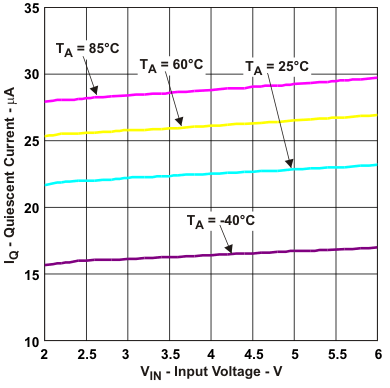 Figure 1. Quiescent Current IQ vs Ambient Temperature (TA)
Figure 1. Quiescent Current IQ vs Ambient Temperature (TA)
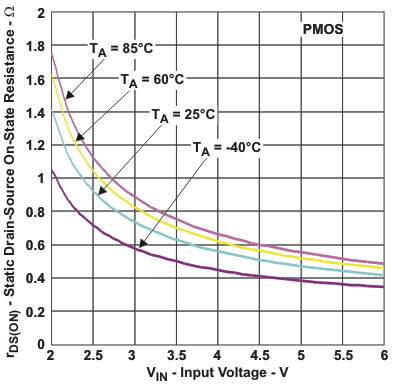 Figure 3. PMOS RDS(ON) vs Supply Voltage VIN and Ambient Temperature (TA)
Figure 3. PMOS RDS(ON) vs Supply Voltage VIN and Ambient Temperature (TA)
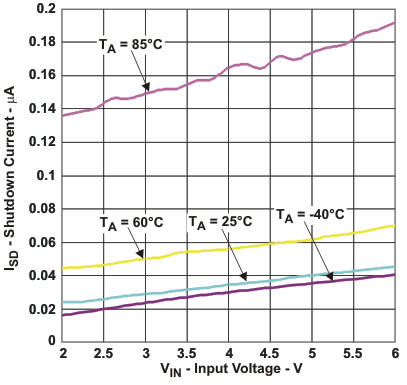 Figure 2. Shutdown Current ISD vs Ambient Temperature (TA)
Figure 2. Shutdown Current ISD vs Ambient Temperature (TA)
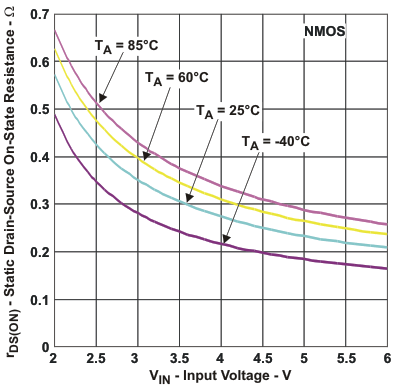 Figure 4. NMOS RDS(ON) vs Supply Voltage VIN and Ambient Temperature (TA)
Figure 4. NMOS RDS(ON) vs Supply Voltage VIN and Ambient Temperature (TA)
7 Detailed Description
7.1 Overview
The TPS6223x-Q1 synchronous step-down converter family of devices includes a unique, hysteretic PWM-controller scheme which enables switch frequencies over 3 MHz, excellent transient and AC load regulation, and operation with cost-competitive external components.
The controller topology supports forced PWM mode as well as power save mode operation. power save mode operation reduces the quiescent current consumption down to 22 μA and ensures high conversion efficiency at light loads by skipping switch pulses. In forced PWM mode, the device operates on a quasi-fixed frequency, avoids pulse skipping, and allows filtering of the switch noise by external filter components. The actual switching frequency depends on the input voltage, output voltage, device mode, and actual load current.
The TPS6223x-Q1 family of devices offers fixed output-voltage options featuring smallest solution size by using only three external components.
The internal switch-current limit of 850 mA (typical) supports output currents of up to 500 mA, depending on the operating condition.
A significant advantage of TPS6223x-Q1 family of devices compared to other hysteretic PWM controller topologies is excellent DC and AC load regulation capability in combination with low output-voltage ripple over the entire load range which makes this device well suited for audio and RF applications.
When the output voltage falls below the threshold of the error comparator, a switch pulse is initiated, and the high-side switch is turned on. This switch remains on until a minimum on time of tONmin expires and the output voltage trips the threshold of the error comparator or the inductor current reaches the high-side switch-current limit. When the high-side switch turns off, the low-side switch rectifier is turned on and the inductor current ramps down until the high side switch turns on again or the inductor current reaches zero.
In forced PWM mode operation, the negative inductor current is allowed to enable continuous conduction mode even at no load condition.
7.2 Functional Block Diagram
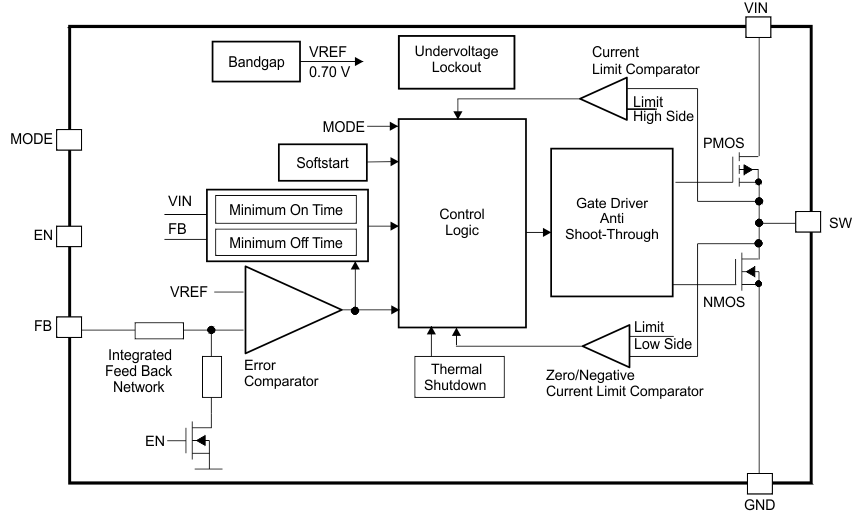
7.3 Feature Description
7.3.1 Undervoltage Lockout
The undervoltage-lockout (UVLO) circuit prevents the device from misoperation at low input voltages. This circuit prevents the converter from turning on the switch or rectifier MOSFET under undefined conditions. The TPS6223x-Q1 family of devices has an UVLO threshold set to 1.8 V (typical). Fully-functional operation is permitted for the input voltage down to the falling UVLO-threshold level. The converter starts operation again when the input voltage crosses the rising UVLO-threshold level.
7.3.2 Enable and Shutdown
The device starts operation when the EN pin is set high and starts up with the soft-start as previously described. For proper operation, the EN pin must be terminated and must not be left floating.
Pulling the EN pin low forces the device into shutdown, with a shutdown quiescent current of 0.1 μA (typical). In this mode, the P and N-channel MOSFETs are turned off, the internal resistor feedback divider is disconnected, and the entire internal-control circuitry is switched off.
The EN input can be used to control power sequencing in a system with various DC-DC converters. The EN pin can be connected to the output of another converter, to drive the EN pin high and getting a sequencing of supply rails.
7.3.3 Thermal Shutdown
As soon as the junction temperature, TJ, exceeds 150°C (typical), the device goes into thermal shutdown. In this mode, the high-side and low-side MOSFETs are turned off. The device continues operation when the junction temperature falls below the thermal shutdown hysteresis.
7.4 Device Functional Modes
7.4.1 Soft Start
The device has an internal soft-start circuit that controls the ramp up of the output voltage and limits the inrush current during start-up. This limits input voltage drops when a battery or a high-impedance power source is connected to the input of the converter.
The soft-start system generates a monotonic ramp up of the output voltage and reaches the nominal output voltage which is typically 100 μs after EN pin was pulled high.
If the output voltage does not reach the target value by this time, such as in the case of heavy load, the converter then operates in a current limit mode set by the switch-current limits.
The device is able to start into a prebiased output capacitor. The converter starts with the applied bias voltage and ramps the output voltage to the nominal value.
7.4.2 Power Save Mode
Connecting the MODE pin to GND enables the automatic PWM mode and power save mode operation. The converter operates in quasi-fixed frequency PWM mode at moderate to heavy loads and in the PFM (pulse frequency modulation) mode during light loads, which maintains high efficiency over a wide-load current range. In PFM mode, the device starts to skip switch pulses and generates only single pulses with an on time of tONmin. The PFM Mode frequency depends on the load current and the external inductor and output capacitor values. The PFM mode of the device is optimized for low output-voltage ripple if small external components are used. Even at low output currents, the PFM frequency is above the audible noise spectrum and makes this operation mode suitable for audio applications.
Use Equation 1 to estimate the on time tONmin.

where
- tON = High-side switch on time (ns)
- VOUT= Output voltage (V)
- VIN= Input voltage (V)
Therefore, use Equation 2 to calculate the approximate peak inductor current in PFM mode.

where
- ILPFMpeak = PFM inductor peak current (mA)
- L = Inductance (µH)
Use Equation 3 to estimate the transition from PFM into PWM mode and from PWM into PFM.

where
- IOUT_PFM/PWM = Output current for transition from PFM to PWM mode and transition from PWM to PFM mode (mA)
7.4.3 Forced PWM Mode
Pulling the MODE pin high forces the converter to operate in a continuous-conduction PWM mode even at light load currents. The advantage is that the converter operates with a quasi-fixed frequency that allows simple filtering of the switching frequency for noise-sensitive applications. In this mode, the efficiency is lower compared to the power save mode during light loads.
For additional flexibility, switch from power save mode to forced PWM mode during operation. This switching allows for efficient power management by adjusting the operation of the converter to the specific system requirements.
7.4.4 100% Duty-Cycle Low-Dropout Operation
The device starts to enter 100% duty-cycle mode when the input voltage comes close to the nominal output voltage. To maintain the output voltage, the high-side switch is turned on 100% for one or more cycles.
With further decreasing VIN, the high-side MOSFET switch is turned on completely. In this case the converter offers a low input-to-output voltage difference which is particularly useful in battery-powered applications to achieve the longest operation time by taking full advantage of the whole battery voltage range.
Use Equation 4 to calculate the minimum input voltage to maintain regulation which is dependent on the load current and output voltage.

where
- VOUTmax = nominal output voltage plus maximum output-voltage tolerance
- IOUTmax = maximum output current plus inductor ripple current
- RDS(on)max = maximum P-channel switch RDSon
- RL = DC resistance of the inductor
7.4.5 Short-Circuit Protection
The device integrates a high-side and low-side MOSFET current limit to protect the device against heavy load or short circuit. The current in the switches is monitored by current-limit comparators. When the current in the P-channel MOSFET reaches the current limit, the P-channel MOSFET is turned off and the N-channel MOSFET is turned on to ramp down the current in the inductor. The high-side MOSFET switch can only turn on again when the current in the low-side MOSFET switch has decreased below the threshold of the current-limit comparator.
8 Application and Implementation
NOTE
Information in the following applications sections is not part of the TI component specification, and TI does not warrant its accuracy or completeness. TI’s customers are responsible for determining suitability of components for their purposes. Customers should validate and test their design implementation to confirm system functionality.
8.1 Application Information
The TPS6223x-Q1 family of devices is a high-frequency, synchronous, step-down DC-DC converter providing switch frequencies up to 3.8 MHz.
8.2 Typical Application
 Figure 5. TPS62231-Q1 1.8-V Output
Figure 5. TPS62231-Q1 1.8-V Output
8.2.1 Design Requirements
The device operates over an input voltage range of 2.05 V to 6 V. The TPS62231-Q1 device has a fixed output voltage of 1.8 V (typical) and the TPS622314-Q1 device has a fixed output voltage of 1.5 V (typical). The device is easy to use and requires just three external components; however, the selection of external components and PCB layout must comply with the design guidelines to achieve the specified performance.
8.2.2 Detailed Design Procedure
8.2.2.1 Output Filter Design (Inductor and Output Capacitor)
The device is optimized to operate with effective inductance values in the range of 0.7 μH to 4.3 μH and with effective output capacitance in the range of 2 μF to 15 μF. The internal compensation is optimized to operate with an output filter of L = 1 μH or 2.2 μH and COUT = 4.7 μF. Larger or smaller inductor and capacitor values can be used to optimize the performance of the device for specific operation conditions. For more details, see the Checking Loop Stability section.
8.2.2.2 Inductor Selection
The inductor value affects the peak-to-peak ripple current, the PWM-to-PFM transition point, the output voltage ripple, and the efficiency. The selected inductor must be rated for DC resistance and saturation current. The inductor ripple current (ΔIL) decreases with higher inductance and increases with higher VIN or VOUT. Use Equation 5 to calculate the maximum inductor current under static load conditions. The saturation current of the inductor must be rated higher than the maximum inductor current as calculated with Equation 6. This rating is recommended because during heavy load transient the inductor current will rise above the calculated value.

where
- L = Inductor value
- f = Switching frequency

where
- ILmax = Maximum inductor current
- ΔIL= Peak-to-peak inductor ripple current
In high-frequency converter applications, the efficiency is essentially affected by the inductor AC resistance (essentially the quality factor) and to a smaller extent by the inductor DCR value. To achieve high efficiency operation, use care when selecting inductors featuring a quality factor above 25 at the switching frequency. Increasing the inductor value produces lower RMS currents, but degrades transient response. For a given physical inductor size, increased inductance usually results in an inductor with lower saturation current.
The total losses of the coil consist of both the losses in the DC resistance, R(DC), and the following frequency-dependent components:
- The losses in the core material (magnetic hysteresis loss, especially at high switching frequencies)
- Additional losses in the conductor from the skin effect (current displacement at high frequencies)
- Magnetic field losses of the neighboring windings (proximity effect)
- Radiation losses
Table 1 lists the inductor series from different suppliers that have been used with the TPS6223x-Q1 converters. These components must be verified and validated to determine whether the component is suitable for the end application.
Table 1. List of inductors
| INDUCTANCE (μH) |
DIMENSIONS (mm3) |
INDUCTOR TYPE | SUPPLIER |
|---|---|---|---|
| 1 | 2.5 × 2 × 1.2 | LQM2HPN1R0MJ0 | Murata |
| 2.2 | 2 × 1.2 × 0.55 | LQM21PN2R2 | Murata |
| 1 or 2.2 | 2 × 1.2 × 1 | KSLI2012 series | Hitachi Metal |
8.2.2.3 Output Capacitor Selection
The unique hysteretic PWM control scheme of the TPS6223x-Q1 device allows the use of tiny ceramic capacitors. Ceramic capacitors with low ESR values have the lowest output voltage ripple and are recommended. The output capacitor requires either an X7R or X5R dielectric. Y5V and Z5U dielectric capacitors, aside from their wide variation in capacitance over temperature, become resistive at high frequencies.
At light load currents the converter operate in power save mode and the output voltage ripple is dependent on the output capacitor value and the PFM peak inductor current. Higher output capacitor values minimize the voltage ripple in PFM Mode and tighten DC output accuracy in PFM Mode.
8.2.2.4 Input Capacitor Selection
Because of the nature of the buck converter having a pulsating input current, a low-ESR input capacitor is required for best input voltage filtering and minimizing the interference with other circuits caused by high input voltage spikes. For most applications a 2.2-μF to 4.7-μF ceramic capacitor is recommended. The input capacitor can be increased without any limit for better input voltage filtering. Because a ceramic capacitor loses up to 80% of the initial capacitance at 5 V, TI recommends using 4.7-μF input capacitors for input voltages greater than 4.5 V.
Take care when using only small ceramic input capacitors. When a ceramic capacitor is used at the input and the power is being supplied through long wires, such as from a wall adapter, a load step at the output or VIN step on the input can induce ringing at the VIN pin. This ringing can couple to the output and be mistaken as loop instability or could even damage the part by exceeding the maximum ratings.
Table 2 lists some tested input and output capacitors. These components must be verified and validated to determine whether the component is suitable for the end application.
Table 2. List of Capacitor
| CAPACITANCE (μF) | SIZE | CAPACITOR TYPE | SUPPLIER |
|---|---|---|---|
| 2.2 | 0402 | GRM155R60J225 | Murata |
| 4.7 | 0402 | AMK105BJ475MV | Taiyo Yuden |
| 4.7 | 0402 | GRM155R60J475 | Murata |
| 4.7 | 0402 | CL05A475MQ5NRNC | Samsung |
| 4.7 | 0603 | GRM188R60J475 | Murata |
8.2.2.5 Checking Loop Stability
The first step of circuit and stability evaluation is to look at the following signals from a steady-state perspective:
- Switching node, SW
- Inductor current, IL
- Output ripple voltage, VOUT(AC)
These signals are the basic signals that must be measured when evaluating a switching converter. When the switching waveform shows large duty-cycle jitter or the output voltage or inductor current shows oscillations, the regulation loop may be unstable. This is often a result of board layout, L-C combination, or both.
As a next step in the evaluation of the regulation loop, the load transient response is tested. The time between the application of the load transient and the turnon of the P-channel MOSFET, the output capacitor must supply all of the current required by the load. VOUT immediately shifts by an amount equal to ΔI(LOAD) × ESR, where ESR is the effective series resistance of COUT. ΔI(LOAD) begins to charge or discharge CO generating a feedback error signal used by the regulator to return VOUT to the steady-state value. The results are most easily interpreted when the device operates in PWM mode.
During this recovery time, VOUT can be monitored for settling time, overshoot, or ringing that helps judge the stability of the converter. Without any ringing, the loop has usually more than 45° of phase margin.
Because the damping factor of the circuitry is directly related to several resistive parameters (for example, MOSFET rDS(on)) that are temperature dependant, the loop stability analysis must occur over the input voltage range, load current range, and temperature range.
8.2.3 Application Curves
 Figure 6. Efficiency: PFM and PWM Mode, 1.8-V Output Voltage
Figure 6. Efficiency: PFM and PWM Mode, 1.8-V Output Voltage
 Figure 8. Comparison Efficiency vs Inductor Value and Size
Figure 8. Comparison Efficiency vs Inductor Value and Size
 Figure 10. 1.8-V Output-Voltage Accuracy, Forced PWM Mode
Figure 10. 1.8-V Output-Voltage Accuracy, Forced PWM Mode
 Figure 12. Switching Frequency vs Output Current, 1.8-V Output Voltage, Mode = GND
Figure 12. Switching Frequency vs Output Current, 1.8-V Output Voltage, Mode = GND
 Figure 14. TPS62231-Q1: Output Voltage, Peak-to-Peak vs Output Current
Figure 14. TPS62231-Q1: Output Voltage, Peak-to-Peak vs Output Current
 Figure 16. Line Transient Response: PFM Mode
Figure 16. Line Transient Response: PFM Mode
 Figure 18. Mode Transition: PFM and Forced PWM Mode
Figure 18. Mode Transition: PFM and Forced PWM Mode
 Figure 20. Load Transient Response: 5m A to 150 mA, PFM to PWM Mode, VOUT 1.8 V
Figure 20. Load Transient Response: 5m A to 150 mA, PFM to PWM Mode, VOUT 1.8 V
 Figure 22. Startup in 1-V Pre-biased Output
Figure 22. Startup in 1-V Pre-biased Output
 Figure 7. Efficiency: Forced PWM Mode, 1.8-V Output Voltage
Figure 7. Efficiency: Forced PWM Mode, 1.8-V Output Voltage
 Figure 9. 1.8-V Output-Voltage Accuracy, PFM and PWM Mode
Figure 9. 1.8-V Output-Voltage Accuracy, PFM and PWM Mode
 Figure 11. Switching Frequency vs Output Current, 1.8-V Output Voltage, Mode = GND
Figure 11. Switching Frequency vs Output Current, 1.8-V Output Voltage, Mode = GND
 Figure 13. Switching Frequency vs Output Current, 1.8-V Output Voltage, Mode = VIN
Figure 13. Switching Frequency vs Output Current, 1.8-V Output Voltage, Mode = VIN
 Figure 15. TPS62231-Q1 1.8-V PSRR
Figure 15. TPS62231-Q1 1.8-V PSRR
 Figure 17. Line Transient Response: PWM Mode
Figure 17. Line Transient Response: PWM Mode
 Figure 19. AC Load-Regulation Performance: 1.8-V VOUT, PFM Mode
Figure 19. AC Load-Regulation Performance: 1.8-V VOUT, PFM Mode
 Figure 21. Load Transient Response: 5 mA to 150 mA, Forced PWM Mode, VOUT 1.8 V
Figure 21. Load Transient Response: 5 mA to 150 mA, Forced PWM Mode, VOUT 1.8 V
9 Power Supply Recommendations
The TPS6223x-Q1 family of devices has no special requirements for the input power supply. The output current of the input power supply must to be rated according to the supply voltage, output voltage, and output current of the TPS6223x-Q1 family of devices.
10 Layout
10.1 Layout Guidelines
As for all switching power supplies, the layout is an important step in the design. Proper function of the device demands careful attention to PCB layout. Use care when designing the board layout to get the specified performance. If the layout is not done carefully, the regulator could show poor line regulation, load regulation, stability issues, and EMI problems. Providing a low-inductance, low-impedance ground path is critical. Therefore, use wide and short traces for the main current paths. Place the input capacitor as close as possible to the IC pins as well as the inductor and output capacitor.
Use a common power GND node and a different node for the Signal GND to minimize the effects of ground noise. Keep the common path to the GND PIN, which returns the small signal components and the high current of the output capacitors as short as possible to avoid ground noise. Connect the FB line to the output capacitor and route the line away from noisy components and traces (for example, SW line).
10.2 Layout Example
 Figure 25. Recommended PCB Layout for TPS6223x-Q1
Figure 25. Recommended PCB Layout for TPS6223x-Q1
11 Device and Documentation Support
11.1 Device Support
11.1.1 Third-Party Products Disclaimer
TI'S PUBLICATION OF INFORMATION REGARDING THIRD-PARTY PRODUCTS OR SERVICES DOES NOT CONSTITUTE AN ENDORSEMENT REGARDING THE SUITABILITY OF SUCH PRODUCTS OR SERVICES OR A WARRANTY, REPRESENTATION OR ENDORSEMENT OF SUCH PRODUCTS OR SERVICES, EITHER ALONE OR IN COMBINATION WITH ANY TI PRODUCT OR SERVICE.
11.2 Documentation Support
11.3 Related Links
The table below lists quick access links. Categories include technical documents, support and community resources, tools and software, and quick access to sample or buy.
Table 3. Related Links
| PARTS | PRODUCT FOLDER | SAMPLE & BUY | TECHNICAL DOCUMENTS | TOOLS & SOFTWARE | SUPPORT & COMMUNITY |
|---|---|---|---|---|---|
| TPS62231-Q1 | Click here | Click here | Click here | Click here | Click here |
| TPS622314-Q1 | Click here | Click here | Click here | Click here | Click here |
11.4 Community Resource
The following links connect to TI community resources. Linked contents are provided "AS IS" by the respective contributors. They do not constitute TI specifications and do not necessarily reflect TI's views; see TI's Terms of Use.
-
TI E2E™ Online Community TI's Engineer-to-Engineer (E2E) Community. Created to foster collaboration among engineers. At e2e.ti.com, you can ask questions, share knowledge, explore ideas and help solve problems with fellow engineers.
-
Design Support TI's Design Support Quickly find helpful E2E forums along with design support tools and contact information for technical support.
11.5 Trademarks
E2E is a trademark of Texas Instruments.
All other trademarks are the property of their respective owners.
11.6 Electrostatic Discharge Caution

These devices have limited built-in ESD protection. The leads should be shorted together or the device placed in conductive foam during storage or handling to prevent electrostatic damage to the MOS gates.
11.7 Glossary
SLYZ022 — TI Glossary.
This glossary lists and explains terms, acronyms, and definitions.

